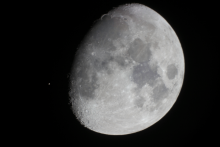Listen to today's episode of StarDate on the web the same day it airs in high-quality streaming audio without any extra ads or announcements. Choose a $8 one-month pass, or listen every day for a year for just $30.
You are here
Moon and Aldebaran
The Moon follows the follower across the sky tonight — the star Aldebaran, the eye of Taurus, the bull. Aldebaran is close to the right of the Moon as night falls, and below the Moon as they drop down the western sky in the wee hours of the morning.
Aldebaran is a red-giant star. It’s at the end of its life, so it’s puffed up to giant proportions. That’s made its surface much cooler than the Sun’s, so the star looks reddish orange. But it’s also much brighter than the Sun, so it’s an easy target.
The name “Aldebaran” comes from an Arabic phrase that means “the follower.” The name indicates that Aldebaran follows the Pleiades across the night sky — a tiny cluster of stars that forms the shoulder of the bull.
Aldebaran itself appears near another star cluster, the Hyades. The cluster forms the V-shaped outline of the bull’s face. Aldebaran is at one point of the V, so it represents the bull’s eye. But Aldebaran isn’t a member of the Hyades. It’s about 65 light-years away, which is only half as far as the Hyades.
Although Aldebaran is one of the brighter stars in the night sky, it won’t look its normal self tonight. Its closeness to the almost-full Moon will make it look a bit pale. And the star’s orange color will be washed out. Even so, Aldebaran will be easy to find — as the “follower” is followed by the brilliant Moon.
We’ll have more about the Moon, Aldebaran, and a circle of other bright stars tomorrow.
Script by Damond Benningfield




